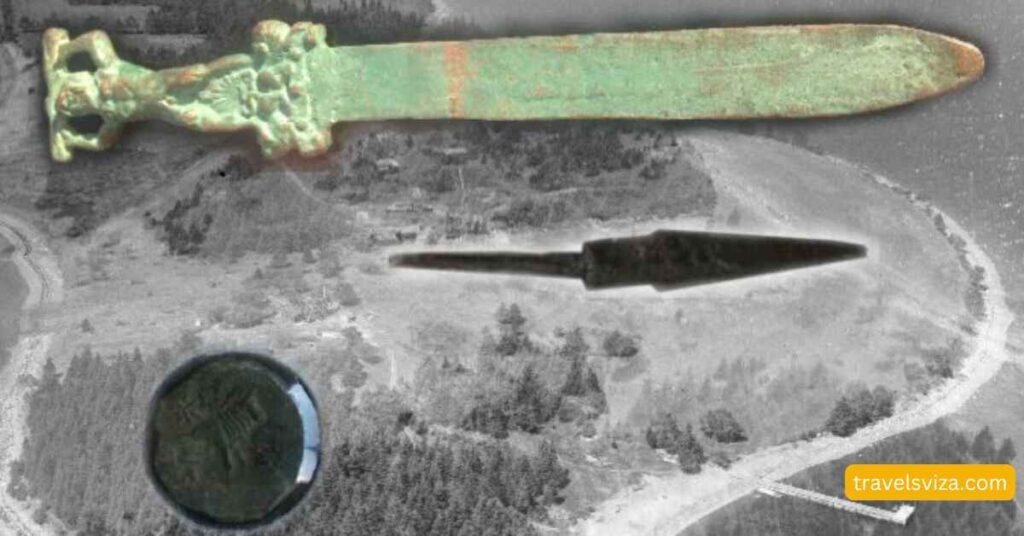Oak Island Canada remains one of the world’s greatest unsolved mysteries. Located off Nova Scotia’s coast, this small isle harbors a legendary treasure pit that has defied explanation for over 200 years.
Despite numerous excavations, advanced technology, and millions invested, the true contents of the Money Pit continue to elude treasure hunters. Six lives have been lost in pursuit of the island’s secrets, with the legend warning that a seventh must die before the treasure reveals itself.
Modern explorers, including Rick and Marty Lagina, continue their determined quest on the History Channel’s “The Curse of Oak Island,” bringing new discoveries and theories to light in their search for answers.
The Discovery of Oak Island’s Money Pit
The Money Pit on Oak Island is one of history’s most fascinating treasure sites. Its discovery sparked centuries of mystery and exploration.
The First Discovery
In 1795, teenager Daniel McGinnis found a strange circular depression under an oak tree. With friends John Smith and Anthony Vaughan, he started digging. They found pick marks on the walls and oak platforms every 10 feet down. Their simple dig would start a 200-year treasure hunt. The boys found old wood beams and coconut fiber layers, unusual items for Nova Scotia.
The Original Money Pit Structure
The Money Pit showed signs of careful engineering. Diggers found wooden platforms at 10-foot intervals down to 90 feet. At this depth, they discovered a stone with strange symbols. Some say it read “40 feet below, two million pounds lie buried.” The pit had a complex flooding system that filled with seawater when diggers got too deep.
Historical Significance
Oak Island’s rich history spans from indigenous settlements to modern treasure hunts.
Early Settlement History
Europeans first settled Oak Island in the mid-1750s. Samuel Ball, a former slave, became a major landowner here. He owned nine lots of land, unusual for his time. The Mi’kmaq people knew the island long before Europeans arrived. The island’s name changed from Smith’s Island to Gloucester Isle, and finally to Oak Island by 1778.
Notable Treasure Hunters

The Onslow Company made the first organized dig in 1803. Future U.S. President Franklin D. Roosevelt joined a treasure hunt in 1909 and kept interest throughout his life. In 2006, brothers Rick and Marty Lagina bought part of the island. They now lead modern exploration efforts shown on The History Channel’s popular show.
Major Oak Island Discoveries Timeline
| Year | Discovery/Event |
| 1795 | Original Money Pit found |
| 1803 | Onslow Company begins first organized dig |
| 1909 | Roosevelt joins treasure hunt |
| 2006 | Lagina brothers buy island stake |
Theories and Speculations
Many theories try to explain Oak Island’s buried secrets, from pirate gold to ancient treasures.
Pirate Treasure Theories
Famous pirates Captain Kidd and Blackbeard sailed Nova Scotia’s waters in the 1700s. Many believe they used Oak Island to hide treasure. Mahone Bay was a known pirate hideout. Old ships’ logs and maps hint at buried pirate gold. Spanish coins found on the island date back to the 1650s lead people to believe in pirate connections.
Secret Society Connections
The Knights Templar might have hidden their treasures here after fleeing Europe in 1307. Stone carvings with Masonic symbols were found on the island. The complex tunnel system matches Templar building styles. A lead cross from the 1300s adds weight to the Templar theory.
Read This Blog: Il Banco Langhe || A Traveler’s Guide to Italian Heritage, Food, and Wine
Modern Investigations
Advanced technology brings new findings in the centuries-old mystery.

Recent Discoveries
Since 2000, teams found human bones, ancient coins, and pottery pieces. Carbon dating of wood samples shows human activity from 1575. Metal detectors located gold traces at 170 feet deep. A gemstone brooch from the 1500s emerged in recent digs.
The Curse of Oak Island
The History Channel show started in 2014. The Lagina brothers use modern tools like seismic testing and ground radar. They found evidence of tunnels and man-made structures. Six people died hunting treasure, leading to the famous curse that seven must die before the treasure is found.
Scientific Perspectives
Science offers natural explanations for Oak Island’s mysteries.
Geological Analysis
Scientists found the island sits on limestone caves. Natural sinkholes explain some deep holes. Underground streams cause the flooding. Studies show the water system is natural, not man-made.
Also Read: The Ultimate Guide to Tioman Island Package: Your Complete 2024 Travel Planner
Engineering Aspects
Modern scanning reveals complex tunnel networks. Ground radar shows old construction sites. New technology maps underground chambers. Environmental studies track the impact of exploration.
Key Discoveries and Scientific Evidence
| Category | Evidence Found | Year |
| Artifacts | Spanish Coins | 1965 |
| Lead Cross | 2018 | |
| Human Bones | 2016 | |
| Geology | Limestone Caves | 1995 |
| Dating | Wood Samples | 1969 |
| Structure | Flood Tunnels | 1850 |
Visiting Oak Island
Oak Island sits in beautiful Mahone Bay, Nova Scotia. While private property limits access, visitors can still experience its mystery.
Tourism Information
Oak Island is closed to the public without special permission. Guided tours run from May to October through the Oak Island Tours Company. Visitors must book well in advance due to high demand. The Interpretive Centre offers displays about the island’s history and artifacts.
The best time to visit is summer when weather is mild and tours run regularly. Nearby Chester and Lunenburg offer historic hotels and seafood restaurants. Mahone Bay town, just 20 minutes away, features craft shops and scenic views.
Local Impact
The treasure hunt brings major benefits to the local economy. Hotels and restaurants see increased business from treasure hunt tourists. The History Channel show created hundreds of jobs since 2014. Local tour companies report full bookings throughout summer months.
The community works hard to protect the island’s environment. Nova Scotia government helps preserve important historical sites. Future plans include an expanded visitor center and more guided tours.
Visitor Information Guide
| Category | Details |
| Tour Season | May to October |
| Booking Required | Yes, advance booking essential |
| Tour Duration | 3-4 hours |
| Nearby Towns | Chester (5km), Lunenburg (20km), Mahone Bay (8km) |
| Accommodation | Available in Chester and Lunenburg |
| Best Visit Time | June to August |
| Transportation | Car rental recommended |
| Facilities | Interpretive Centre, Gift Shop, Restrooms |
Local Attractions Near Oak Island:
- Chester Waterfront – 5km
- Lunenburg UNESCO Site – 20km
- Mahone Bay Three Churches – 8km
- Oak Island Museum – On-site
- Tancook Island Ferry – 10km
Visitor Tips:
- Book tours at least 2 months ahead
- Wear comfortable walking shoes
- Bring weather-appropriate clothing
- Plan for a full day visit
- Follow all site safety rules
FAQ
What is the Oak Island Money Pit?
The Money Pit is a mysterious shaft discovered in 1795 on Oak Island. It contains man-made tunnels and platforms going deep underground, with a complex flooding system.
Has any treasure been found on Oak Island?
While no major treasure has been found, searchers discovered coins, jewelry, bone fragments, and ancient artifacts. A lead cross from the 1300s is the most significant find.
Who currently owns Oak Island?
Oak Island is owned by Oak Island Tours Inc. Rick and Marty Lagina own a controlling 50% stake, with the remaining shared by other partners.
How many people have died searching for treasure?
Six people have died during treasure hunting operations on Oak Island. The first death occurred in 1861, and the most recent in 1965.
What is the Oak Island curse?
The curse states seven people must die before the treasure can be found. With six deaths so far, this legend adds to the island’s mystery.
Can tourists visit Oak Island?
Yes, tourists can visit through guided tours from May to October. Advanced booking is required as the island is private property.
Conclusion
Oak Island’s Money Pit remains one of the world’s greatest unsolved mysteries after 200 years of searching. While modern technology reveals new clues, the ultimate truth behind its tunnels and artifacts stays hidden.
Whether pirate gold or Templar treasure, this Nova Scotia island continues to captivate treasure hunters and history lovers worldwide.